If you’re a birdwatching enthusiast seeking the optimal blue jay spotting season, you’re in luck as North America enters the best season for seeing more blue jays. It’s during the colorful transition of fall when these vibrant creatures become most conspicuous, presenting a fantastic opportunity for blue jay observation. This period is not only a visual treat but also the most active phase for blue jays, making it the prime time for observers to watch these birds in their natural habitats.
Key Takeaways
- Autumn marks the best season for seeing more blue jays, aligning with harvest times and social bird behaviors.
- Birdwatching during this season rewards you with vibrant blue jay observations against the picturesque fall backdrop.
- Data from eBird highlights an increased number of blue jay sightings, reinforcing the fall as an optimal blue jay spotting season.
- The fall’s abundance in food sources contributes to the higher visibility of blue jays.
- For birdwatchers in North America, late summer to early fall is touted as the peak period for blue jay observation.
- Engaging in birdwatching during this season offers a deeper understanding of blue jay behavior and social interactions.
Unveiling the Social Behavior of Blue Jays in Fall
As the fall season unfurls its rustic tapestry, the blue jay’s social behavior enters a fascinating phase that’s keenly observable by avid bird enthusiasts. This transition period, marked by crisp air and dwindling daylight, prompts these social birds to become especially vibrant and active within their communities. If you find yourself immersed in the hues of autumn, your ears might catch the sharp, resonating sounds that are indicative of blue jay behavior.
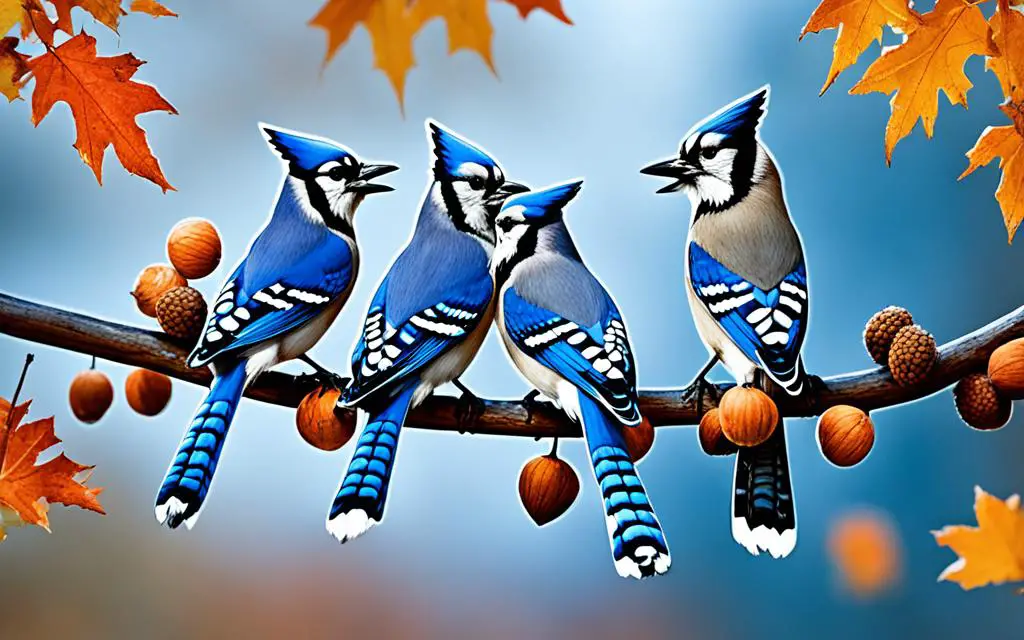
Why Autumn Brings More Activity
The cooler fall season is a time of abundance and reunion for blue jays, leading to a discernible surge in their communal activities. Their noisy calls, a hallmark of their presence, punctuate the early mornings and evenings, echoing through the domain as a sound announcement of their gatherings. The season is ripe with harvest, providing plentiful food, which bolsters the energy levels of these agile creatures, thus encouraging their sprightly interaction within family groups.
Understanding the ‘Jay’ Call
The iconic “jay” call is more than just a random noise; it is a cornerstone of bird behavior, serving as a communication tool among the blue jays. These vocalizations, sharp and clear, function as identifiers and alerts to others in their group, especially during the fall when they often reunite or establish territories. Understanding this behavior offers you a unique vantage point into the complex social dynamics that govern these intelligent creatures and enriches your birdwatching experience.
Whether you’re a seasoned birder or just enjoy the casual perk of witnessing wildlife from your backyard, staying attuned to these behaviors can enhance your appreciation for the natural world. Fall’s stage is set, and the blue jays, with their vibrant plumage and fascinating social interactions, are the performers. So, grab your binoculars and step outside—there’s a veritable avian theater waiting for you.
Best Season for Seeing More Blue Jays
Have you ever wondered when to see blue jays in abundance? Your curiosity coincides with the peak blue jay viewing season. As autumn approaches, the vivid colors of changing leaves provide a stunning backdrop for the brilliant blue plumage of these birds. Whether you’re an experienced birder or simply enjoy the casual glance skyward, knowing the prime time for blue jay observation can make all the difference in experiencing these charming birds.
The late summer to fall transition is not only picturesque but is also the top months for blue jay sightings. During this time, blue jays are notably more social, gathering in noisy family groups which are quite the spectacle. It’s the time when blue jays gear up for the colder months ahead, manifesting in increased activity—particularly at bird feeders, where their assertive nature is often observed.
If your aim is to witness these beautiful creatures, the prime time for blue jay observation should definitely be on your radar. This season, marked by cooler temperatures and plentiful harvests, provides an opportunity to see blue jays in abundance, engaging in both feeding and migration behaviors. Setting out bird feeders during these months might reward you with frequent blue jay visits, as they prepare for the winter.
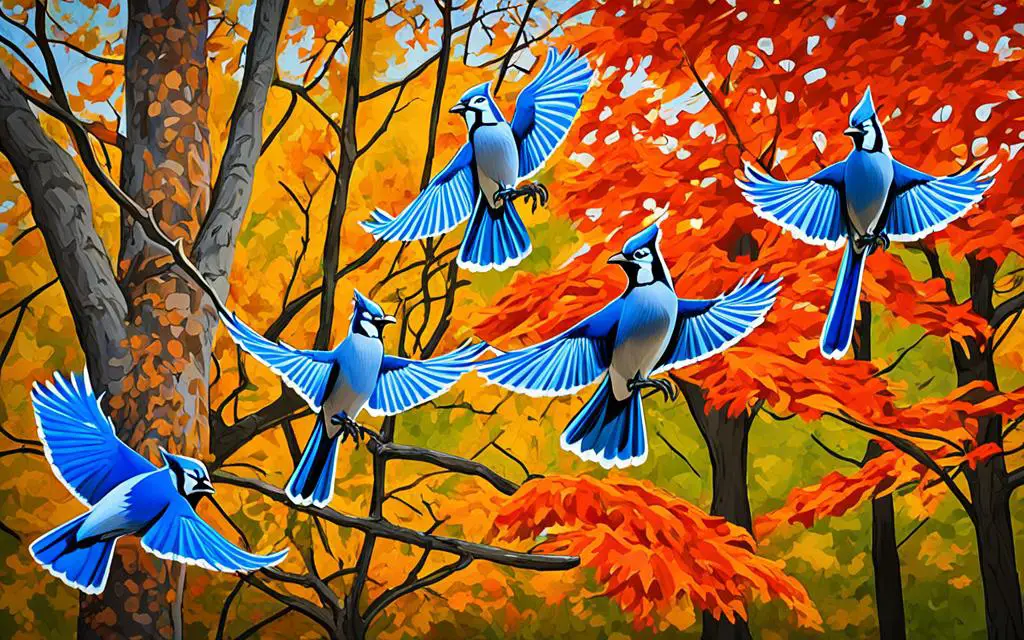
Thus, if you’re planning your birdwatching activities, align them with the peak blue jay viewing season. Keep your binoculars at the ready and your bird feeders stocked. The fall months promise a delightful symphony of blue jay calls and an array of blue-winged visitors to your backyard. It’s a time when nature invites you to partake in the mesmerizing dance of birdlife, and blue jays are undoubtedly one of autumn’s most vibrant stars.
Blue Jays’ Notable Presence at Bird Feeders
As the leaves begin to turn and the air grows crisp, your backyard bird feeder becomes a stage for nature’s vibrant performers. Among the most striking visitors are the blue jays, whose dazzling blue plumage and lively antics can make backyard birdwatching a true delight. With their penchant for seeds and nuts, these backyard birds are frequent guests at bird feeders, providing endless entertainment and observation opportunities for avian enthusiasts.
Feeding Habits and Favorite Foods
Have you noticed the increased activity around your bird feeder this season? Blue jays are often found busily scouring for their favorite foods. With voracious appetites, these birds make the most of the abundance provided by nature and generous backyard hosts alike. Their diet is as varied as their calls are vibrant, enjoying a smorgasbord that includes fallen nuts, hearty seeds, and even the occasional worm. But what truly gets blue jays talking are peanuts—be it shelled, unshelled, or even creamy peanut butter.
If you’re keen to witness the acrobatic flights and listen to the distinctive calls of blue jays, consider furnishing your bird feeder with their go-to snacks. Below is a table highlighting the favorite foods of blue jays that could attract them to your bird feeder:
| Favorite Food | Blue Jay’s Response |
|---|---|
| Peanuts | Most likely to attract a noisy group |
| Sunflower Seeds | Often the first choice at feeders |
| Corn | Eaten with gusto, especially cracked corn |
| Suet | Preferred during colder months |
How to Attract Blue Jays to Your Yard
Wish to make your backyard the favored local haunt for blue jays? Attracting these charismatic creatures is easier than you might think. If you set out tray feeders or hopper feeders brimming with their preferred seeds and nuts, you’re likely to become a hotspot on the blue jay map. To ensure they stick around, provide a reliable water source. A simple birdbath can serve as an oasis for these birds, particularly during the dry, hot months when they’re nurturing their young. Not only do these measures feed blue jays, but they also provide you with a ringside seat to the social dynamics of these intelligent birds.
Remember, blue jays are not just any backyard bird—they are a brilliant spectacle with a penchant for the theatrical. So, keep your binoculars handy and your camera at the ready, because when you attract blue jays to your feeder, you’re in for a winged extravaganza that could rival any fall foliage display.
Dissecting Blue Jay Intelligence and Social Structures
The intelligence of blue jays is not a matter of mere observation but a point of scientific consensus. As part of the corvidae family, they stand among the avian world’s most cerebral. Their sophisticated social structures reflect tight-knit community bonds that echo through the tree branches with every call and interaction. Beyond their intelligent navigation of social dynamics, it is their ability to perform mimicry that truly showcases their cognitive prowess. If you’re looking to unravel how blue jays employ their smarts in the wild, pay close attention to their compelling interactions!
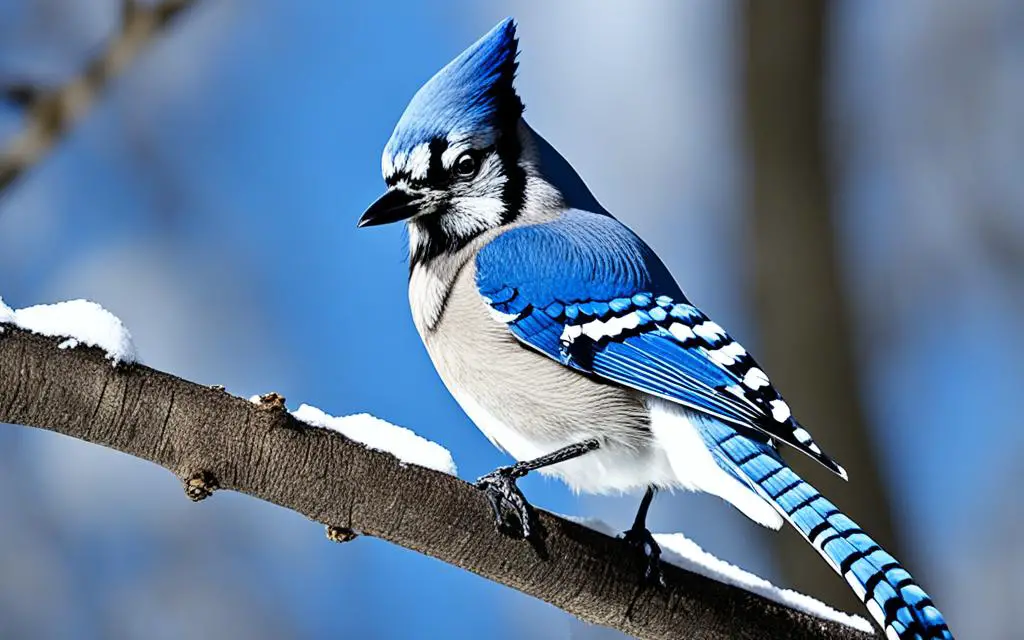
For example, blue jays are residents in many North American regions, yet their impact on their ecosystem is profound. They take on roles similar to neighborhood watch, employing mimicry of predators like hawks to protect their territories—an act of both intelligence and coordination. Anecdotes from bird lovers often highlight the sight of blue jays executing imitations so convincing that they can alter the behavior of other birds, evidence of deep-rooted social structures within their groups.
These birds are known for solving complex problems and using tools—traits that vividly illustrate their intelligence. Among resident birds, they are unparalleled in their ability to adapt to new challenges, often driven by the seasonal changes their environments undergo. Let’s delve deeper with a comparative look at blue jay social behaviors:
| Behavior | Indication of Social Structure |
|---|---|
| Territorial Calls | Community coordination and territory defense |
| Feeding Flocks | Sharing resources and bonding |
| Nest Construction | Pair cooperation and future planning |
| Playful Antics | Learning and social interaction |
As you observe these captivating birds, consider the intricate social tapestry they weave. Each act, be it a shared meal from a generous feeder or a coordinated defense against a roaming hawk, is part of a larger, intelligent design. Their affinity for acorns leads them to oak trees, where often these social structures are most visible. Here they commune, strategize, and thrive, solidifying their status within the intelligent ranks of the corvidae family.
In your own backyard, observing the conduct of blue jays can offer a window into their communal intelligence. Whether it’s through their dominance at the bird feeder or the clever concealment of their nests, blue jays’ actions are underpinned by discerning cognition—an attribute that continuously fascinates birdwatchers and casual observers alike.
Exploring the Habitat and Nesting Choices of Blue Jays
Discovering the intricacies of blue jay habitats highlights the importance of forest preservation and ecological understanding. As you explore woodlands or your own backyard, you may encounter the distinctive nests of blue jays, which offer insights into their survival strategies and preferences. Let’s delve into the preferred environments and the threats that blue jays face as they nurture their next generation.
Preferred Trees for Blue Jays’ Nests
When it comes to nesting, blue jays have shown a clear predilection for the mighty oak trees found within the diverse woodlands of North America. These trees provide sturdy branches for blue jays to construct their homes, taking full advantage of the camouflage offered by the oak’s dense foliage. The selection of nesting sites in these trees serves dual purposes: securing a reliable food source in acorns and offering a strategic vantage point for monitoring the safety of their chicks.
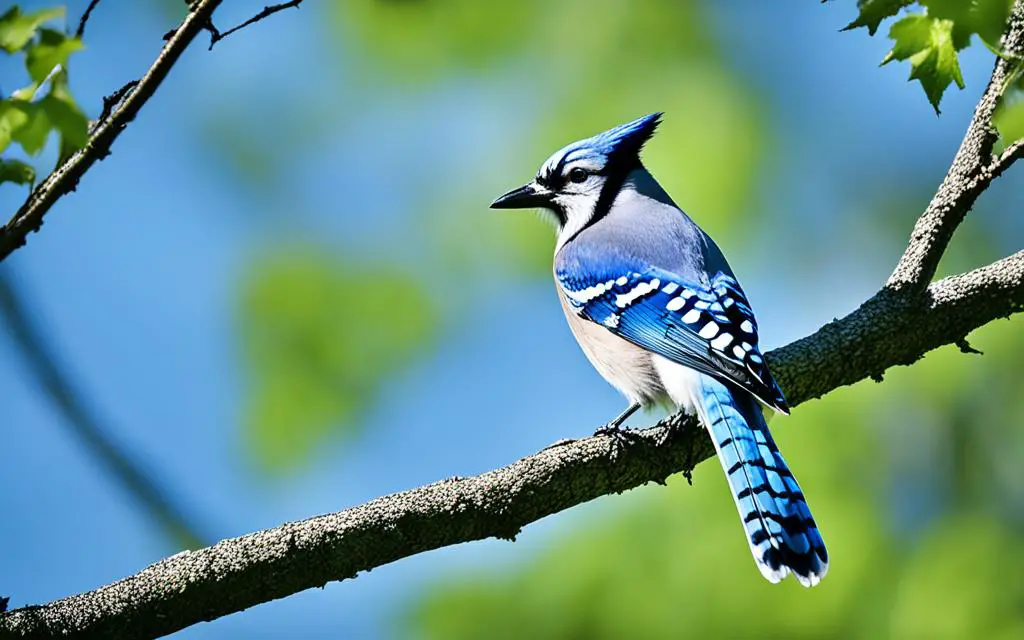
Predators and Threats to Nesting Success
In the wild, blue jays meticulously craft their nests in the crotch or thick outer branches of deciduous and coniferous trees, finding security in heights ranging from 10 to 25 feet above the ground. This elevated sanctuary, however, is not impervious to the perils of predators. A host of species, including hawks, owls, falcons, and even resourceful squirrels, pose significant risks to the survival of vulnerable blue jay eggs and nestlings. Yet, do not underestimate the fierce protective instincts of blue jays; these birds are known to aggressively guard their nests, ensuring the continuity of their lineage against all odds.
The intertwining lives of blue jays and their predators underscore a delicate balance within our forests and woodlands. As guardians of these habitats, your awareness and actions contribute to the well-being and continuity of these vibrant bird communities. By recognizing the significance of each species and taking steps to protect their environments, you play a pivotal role in ensuring the survival and flourishing of blue jays and other woodland inhabitants.
Deciphering the Migration Patterns of Blue Jays
As you observe the array of wild birds darting through the skies of North America, you’ll notice that blue jays, typically resident birds, sometimes exhibit unpredictable migration behaviors. These shifts in blue jay patterns offer an intriguing puzzle to bird enthusiasts and ornithologists alike. But what guides the decision of these vibrant birds to either stay put or venture to warmer climates?
Let’s unwrap the mystery surrounding the blue jay’s choice to migrate. Unlike several other species with fixed migratory courses, blue jays are unique in their variability. They don’t follow a clear-cut pattern every year, making their annual movements a source of fascination and speculation. Some years, you might witness a blue jay choose a southern journey as the chill of winter approaches, while other years the same bird may brave the cold, remaining in its northern habitats.
What could be influencing these sporadic travels? While it’s hard to predict with certainty, various factors might play a role in their decision to migrate, including food availability, weather patterns, and ecological shifts. This table highlights the primary hypotheses behind their sporadic migration:
| Possible Influence | Effect on Blue Jay Migration |
|---|---|
| Food resources | Scarcity or abundance may prompt movement |
| Weather conditions | Harsh winters can drive southward migration |
| Ecological changes | Alterations in habitat can influence staying or going |
| Social dynamics | Community behavior may encourage group migrations |
Yet, despite these potential factors, the inner workings of migratory decision-making for blue jays remain enigmatic. This lack of a consistent pattern makes each sighting of these majestic birds all the more special, whether they’re preparing to embark on a migration or settling in for the winter months nearby. In either case, observing the behaviors of blue jays continues to be a source of endless wonder for those of us enchanted by the annual drama of bird migrations.
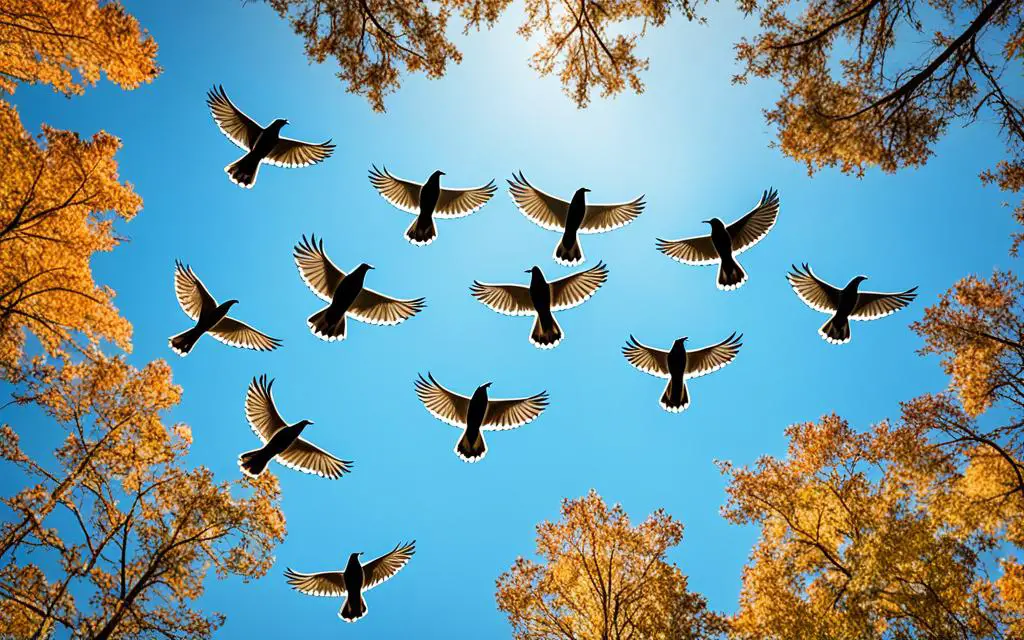
Your own backyard could very well be a window to this avian mystery. By keeping a watchful eye and perhaps noting your own observations, you too can contribute to the understanding of blue jay migration. Whether you’re filling your feeders to entice these lovely birds to linger a little longer or simply enjoying their fleeting visits, the unpredictable nature of their travels is a reminder of the dynamic tapestry of life that surrounds us.
Understanding Blue Jay Behavior Across Seasons
As the seasons shift from the blooms of spring to the long, warm days of summer, blue jays exhibit a range of complex behaviors, intricately tied to the rhythm of the natural world. You may notice, during these months, a striking change in these vibrant birds—their presence at feeders becomes less frequent, and their calls, which once echoed robustly, now subtly blend with the serenity of the season. This seasonal behavior is part of the blue jays’ breeding cycle, an engaging aspect of bird observation that captivates enthusiasts.
Breeding Behavior in Spring and Summer
When nature wears its veil of new green leaves and floral scents, blue jays embark on the task of creating the next generation. Their focus turns towards building secure nests and raising their young—a private time for these birds. For you, the avid bird watcher, understanding these breeding behaviors offers an insightful glance into the life-cycle of blue jays, despite them being less visible during this nurturing phase.
Diligently selecting nest sites and carefully constructing their abode, blue jays demonstrate their commitment to offspring survival. Male and female blue jays work collaboratively to ensure their young emerge into a safe and nourishing environment. Such intricate behaviors are prime examples of nature’s enduring cycles and the adaptations creatures endure to thrive across seasonal changes.
Changes in Blue Jay Observation Based on Season
With each passing season, your chances of spotting a blue jay can fluctuate. As fall approaches, blue jays return to a more visible and audible state, contrasting their summer’s covert behavior. The rustling foliage of autumn becomes a canvas for these birds to gather, feast, and prepare for the migration ahead—making it an opportune time for you to observe these beautiful birds in action.
As profound as the fall foliage itself, the vivid blues of the jays stand out against the oranges and yellows of the trees, their sociability peaking in preparation for the colder days to come. If you find patience to be a virtue, your bird observation sessions will be rewarded with this bustling activity, seemingly choreographed against the backdrop of ongoing seasonal changes.
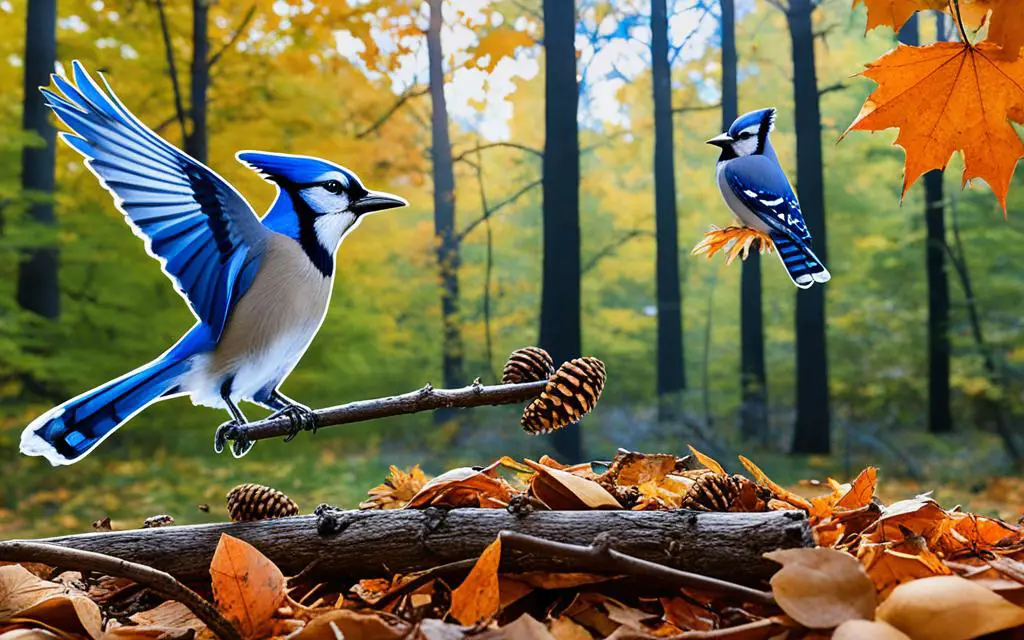
This cycle of changing visibility and behavior provides a unique and endearing narrative of these winged wonders. If you observe closely, you will begin to perceive the seasonal patterns of wildlife, providing a deeper appreciation for the intricacy of each species’ survival strategy. So, keep your eyes keen and your mind curious as blue jays unfold the story of their lives season after season.
Witnessing the Splendor of Blue Jays’ Plumage
If you’re captivated by the sight of colorful birds, the blue jay’s vivid appearance epitomizes the essence of avian beauty. With a striking crest that adds to their regal demeanor and vibrant blue wings that capture the eye, blue jays are the quintessence of natural artistry in the bird world. Their distinct white markings create a stark contrast against their deep blue feathers, ensuring these common birds are always the center of attention.
The blue jays’ long tail feathers extend elegantly behind them as they glide through the air, an identifiable feature that enhances their already stunning profile. As you watch them in their natural habitat, you’ll understand why blue jays are often considered among the most magnificent of North America’s winged inhabitants.
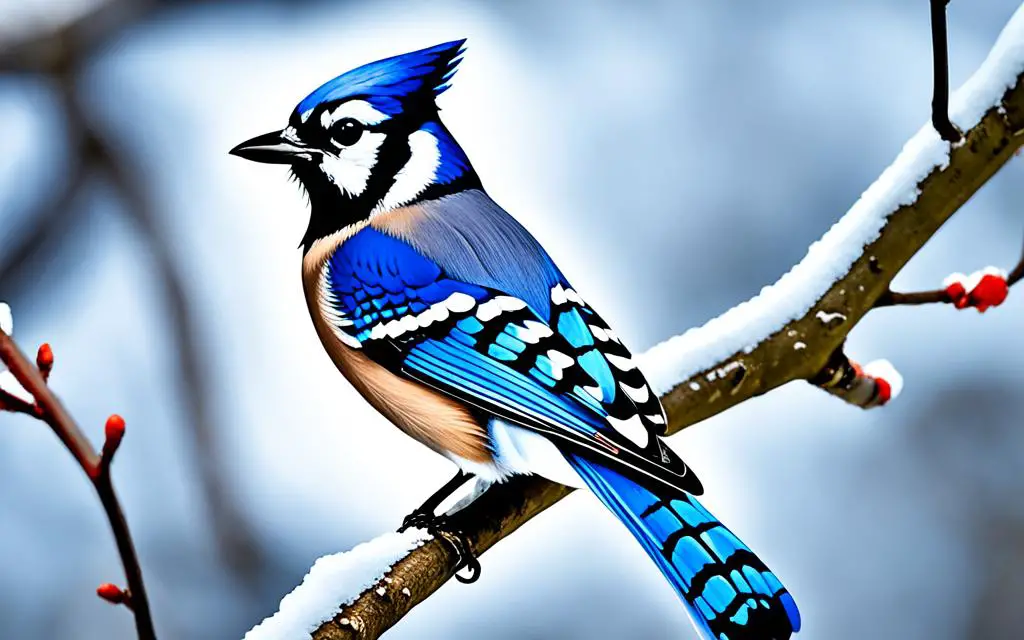
Observe them against the various seasonal landscapes, and you’ll witness a breathtaking tableau where the blue jay becomes the protagonist. The crisp backdrop of autumn leaves, the stark branches of winter trees, or the lush greenery of summer—each setting stages a different scene for these colorful birds to shine. Their beauty is not just a feast for the eyes but also a testament to the diverse palette of the natural world.
Often found perched with poise or pecking at the ground for food, blue jays carry an air of charisma that’s hard to miss. Whether they’re bouncing around your backyard feeder or nesting high in the forest canopy, they exemplify the splendor of birdlife. Get your binoculars ready, for the blue jay is a creature that asks you to pause and appreciate the details—a crest here, a flutter of blue wings there, and the dance of white markings that narrate a story all their own.
Relationship Between Food Sources and Blue Jay Sightings
As you explore the woodlands and your own backyard this fall, have you noticed an increase in blue jay sightings? This uptick in blue jay presence is tightly bound to the abundance of food sources available during the autumn months, particularly acorns. Let’s delve into this relationship to discover why the blue jay becomes a more common visitor during this time.
The Impact of Acorn Abundance
Every few years, oak trees enter a masting cycle, producing a bumper crop of acorns that become irresistible to wildlife, including blue jays. The masting cycle, occurring roughly every 2-5 years, plays a vital role in shaping the migratory and feeding patterns of these birds. Acorn surges allow for plentiful, accessible food, making certain areas hotspot destinations for blue jays.
During these masting periods, the forest floor is awash with acorns, creating a feast for blue jays who rely on these nuts as a primary food source. Their nomadic behavior adjusts accordingly, with many blue jays gravitating towards regions known for their dense oak tree populations.
Seasonal Food Preferences of Blue Jays
In addition to acorns, the blue jay diet is quite diverse. Throughout different seasons, these birds adapt their feeding habits to include a variety of nuts, seeds, berries, insects, eggs, and even nestlings. The table below outlines the changes in blue jay food preferences as the seasons shift, highlighting fall as a particularly pivotal period due to the masting cycle:
| Season | Preferred Food |
|---|---|
| Spring | Insects, berries, seeds |
| Summer | Berries, insects, eggs, nestlings |
| Fall | Acorns, nuts, seeds |
| Winter | Stored nuts, seeds |
With autumn’s generous offerings, blue jays are more than happy to stay within an area rich in their favored food sources, especially acorns, which provide a substantial energy reserve for the impending winter. So, if you’re eager to spot more of these beautiful, intelligent birds, now’s the time to take a walk near wooded areas where oaks abound—you may just enjoy your own blue jay bonanza.
The Role of Human Interaction in Blue Jay Behavior
Your forays into backyard bird-feeding may be shaping the behavior of one of America’s most charismatic avian residents: the blue jay. With their striking plumage and intelligent antics, these birds have become a symbol of the suburban wilderness. But did you know your interactions with these feathered neighbors could affect their daily routines? Drawing closer to the influence humans enact upon blue jay activity gives you the chance to play a direct and responsible role in their local ecosystem.
Do Blue Jays Recognize Human Faces?
Imagine stepping outside to fill your bird feeder and being greeted by a familiar flutter of wings. Studies suggest that this is no random encounter; blue jays are capable of recognizing human faces. These observant creatures might even follow you, driven by curiosity or the expectation of a treat. This potential for backyard interaction not only bonds you with nature but also poses an intriguing question about the cognitive abilities of blue jays. As you become a regular provider, these discerning birds may count you as part of their extended community.
Impacts of Backyard Bird Feeding on Blue Jay Activity
Keeping your bird feeders well-stocked with a bounty of seeds and nuts can dramatically influence blue jay activity around your home. From a single visitor to a full-fledged party, the blue jays will eagerly frequent gardens where food is plentiful. Incorporating a varied diet at your feeding stations increases the likelihood of these birds becoming regular guests, adding vibrancy and life to your backyard. And let’s not neglect the essential role of birdbaths; providing a reliable water source can enhance the wellness of your winged friends, encouraging their health and hygiene.
Your engagement in bird feeding practices does more than entertain; it nurtures a symbiotic relationship with blue jays, ensuring they remain an enduring and joyful presence in our shared environments. So, the next time you hang a feeder or fill a birdbath, consider the positive impacts of your human interaction with these spirited birds, and know that with each seed you dispense, you’re fostering a deeper connection with the natural world right in your own backyard.
FAQ
What is the best season for seeing more blue jays?
Why do we see more blue jay activity in the fall season?
How can one recognize the ‘jay’ call?
When is the prime time for blue jay observation?
What are blue jays’ favorite foods at bird feeders?
How can you attract blue jays to your yard?
How intelligent are blue jays and what social structures do they exhibit?
Where do blue jays prefer to build their nests?
What predators pose threats to blue jays’ nesting success?
Are blue jays migratory or resident birds?
How does blue jay behavior change across seasons?
What makes blue jays’ plumage so noticeable?
How does the abundance of acorns affect blue jay sightings?
Do blue jays recognize human faces?
How does backyard bird feeding impact blue jay activity?
Source Links
- https://www.reptileknowledge.com/reptile-pedia/what-time-of-year-are-blue-jays-most-active
- https://b105country.com/seeing-more-blue-jays-this-fall-in-minnesota-heres-why/
- https://utdmercury.com/blue-jays-come-out-of-hiding-for-spring/

My name is Shane Warren, the author behind Your Bird Buddy – your ultimate guide to the wonderful world of birds! Unleash your inner avian explorer as we delve into a vibrant library of knowledge dedicated to all things feathered. From learning about diverse bird species from across the globe to understanding their captivating habitats and behaviors, I’m here to fuel your passion for these magnificent creatures. Not only that, but I also provide valuable insights on being a responsible and informed pet bird owner. Join our vibrant community and let’s celebrate the feathered wonders of the world together – one chirp at a time. And be sure to join our Your Bird Buddy Community over on Facebook!

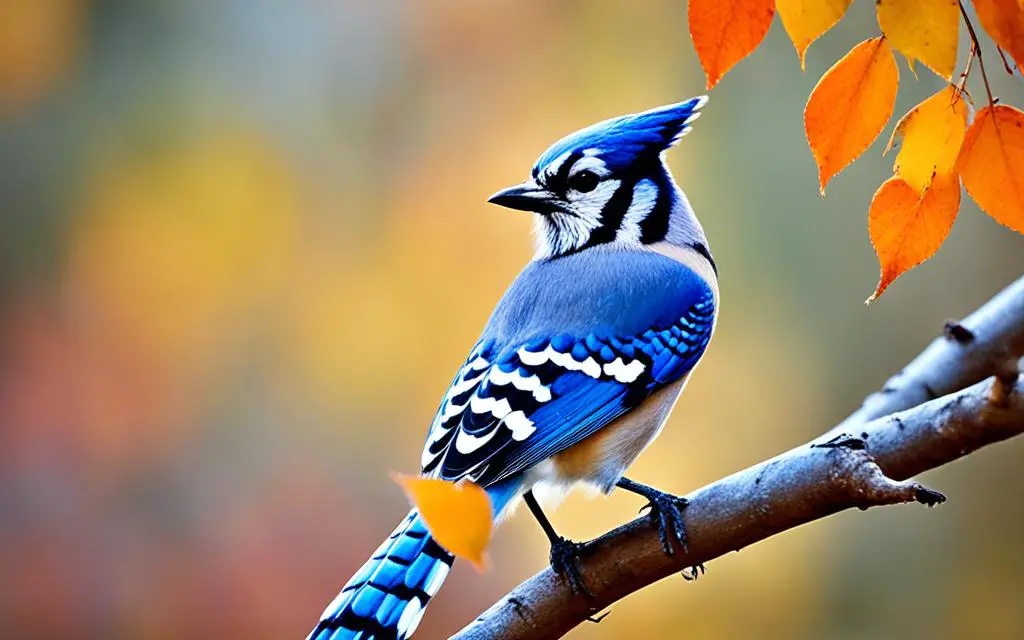
Comments are closed